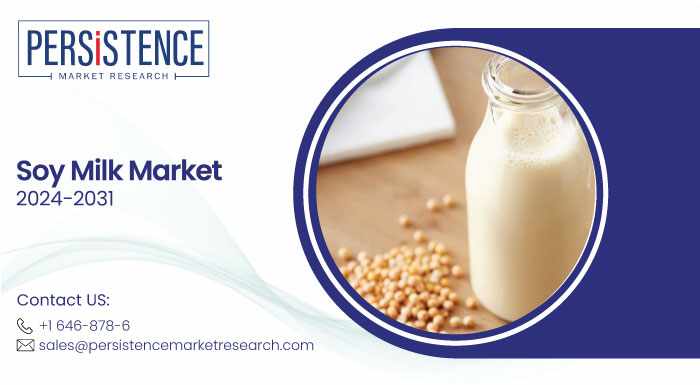
The global soy milk market is experiencing significant growth as consumers increasingly turn to plant-based alternatives in response to rising health consciousness, dietary restrictions, and environmental concerns. Soy milk, which has long been a staple in many Asian countries, is now gaining popularity worldwide as a nutritious and sustainable alternative to dairy milk. In this blog post, we explore the key trends, emerging opportunities, and forecasts for the soy milk market, providing insights into its future trajectory.
Read More: https://www.persistencemarketresearch.com/market-research/soy-milk-market.asp
Market Overview
Soy milk is made from ground soybeans and is naturally free from lactose, cholesterol, and dairy. It offers several health benefits, including being rich in protein, vitamins, and essential fatty acids. Its widespread appeal is further bolstered by its versatility—soy milk can be consumed as a beverage or used in cooking and baking. As more people adopt plant-based diets or seek dairy-free alternatives, the soy milk market is experiencing substantial growth globally.
Key Trends in the Soy Milk Market
Rising Demand for Plant-Based Products
One of the most prominent trends in the food and beverage industry is the growing demand for plant-based products. As more consumers adopt vegan, vegetarian, and flexitarian diets, plant-based beverages like soy milk are becoming an integral part of their daily routines. Soy milk is gaining popularity as a dairy substitute in coffee, smoothies, cereals, and baking. Its rich, creamy texture and nutritional profile make it a versatile and appealing option for people across the globe.Health-Conscious Consumer Behavior
With an increasing focus on wellness and healthy living, consumers are seeking food and beverage options that align with their health goals. Soy milk is a healthy alternative to traditional dairy milk, offering benefits such as being low in saturated fat, rich in protein, and fortified with essential vitamins like B12 and D. Its ability to support heart health, lower cholesterol, and reduce the risk of certain cancers is attracting health-conscious individuals. This trend is further supported by the growing awareness of the health risks associated with dairy consumption.Lactose Intolerance and Allergies
Lactose intolerance is a significant concern for many consumers, especially in regions like Asia and North America, where dairy consumption is common. Soy milk’s lactose-free nature makes it an appealing alternative for individuals with lactose intolerance. Additionally, people with dairy allergies or those avoiding animal-based products for ethical reasons are turning to soy milk as a safe, nutritious option. This trend is driving demand, particularly in markets where health-conscious consumers seek alternatives to traditional milk.Sustainability and Environmental Impact
As sustainability becomes a central concern for modern consumers, plant-based milk alternatives are gaining favor for their lower environmental impact compared to dairy milk. Soy milk requires fewer resources—such as water, land, and feed—than animal-based dairy farming. Additionally, soy milk production generates fewer greenhouse gas emissions. With a growing interest in reducing environmental footprints, more consumers are opting for soy milk as a way to support sustainable and eco-friendly food practices.Flavored and Fortified Soy Milk
To cater to diverse consumer preferences, manufacturers are introducing new and innovative soy milk products. Flavored soy milk, such as vanilla, chocolate, and matcha, is gaining popularity, appealing to a wider audience. Additionally, many soy milk products are fortified with calcium, vitamins, and minerals to closely resemble the nutritional profile of dairy milk. These innovations are not only enhancing the appeal of soy milk but also positioning it as a functional and convenient alternative to traditional dairy.
Opportunities in the Soy Milk Market
Expanding Market in Emerging Economies
While soy milk has seen widespread acceptance in regions like North America and Europe, its potential for growth is particularly strong in emerging economies such as Asia-Pacific, Latin America, and the Middle East. As awareness of the benefits of plant-based diets increases in these regions, soy milk is poised to capture a larger share of the dairy alternatives market. In particular, countries with high lactose intolerance rates, such as China and India, represent significant opportunities for growth.Innovative Product Development
Companies in the soy milk market are continuously innovating to meet the evolving demands of consumers. There is a growing opportunity to create new products that cater to specific dietary needs, such as organic, non-GMO, or fortified soy milk options. As plant-based diets become more mainstream, product diversification will be key to attracting new customers. Additionally, manufacturers can tap into the rising demand for sustainable packaging, using eco-friendly materials to appeal to environmentally-conscious consumers.Soy Milk in Food Applications
Soy milk is not just a beverage; it is increasingly being used as an ingredient in various food products. From dairy-free yogurts and cheeses to ice creams and baked goods, soy milk is playing a vital role in the creation of plant-based foods. The growing demand for dairy-free and vegan alternatives in the food industry presents significant opportunities for soy milk manufacturers to expand their product offerings and penetrate new market segments.Increased Distribution Channels
The increasing demand for soy milk presents a vast opportunity for manufacturers to expand their distribution networks. E-commerce platforms are gaining traction, providing consumers with convenient access to soy milk products. Traditional retail channels, such as supermarkets and health food stores, also present growth opportunities. Manufacturers can leverage both physical and online retail channels to reach a broader customer base and increase brand visibility.
Market Forecasts and Growth Projections
The global soy milk market is projected to continue growing at a strong pace over the next several years. According to industry reports, the market is expected to expand at a compound annual growth rate (CAGR) of approximately 6-7% during the forecast period from 2024 to 2030. This growth will be driven by the increasing adoption of plant-based diets, the expansion of the vegan and dairy-free product categories, and the growing consumer awareness around health and sustainability.
The Asia-Pacific region will remain the dominant market for soy milk due to its long-standing consumption of soy-based products. However, North America and Europe are expected to witness substantial growth as well, with increasing consumer interest in plant-based diets and lactose-free alternatives.
Challenges Facing the Soy Milk Market
Competition from Other Plant-Based Milks
While soy milk has carved out a significant niche in the plant-based milk market, it faces strong competition from other popular alternatives, such as almond milk, oat milk, and coconut milk. These alternatives have gained significant traction due to their own unique health benefits and flavors. To maintain its market share, soy milk must continue to innovate and differentiate itself from these competitors.Allergen Concerns
Soy milk may not be suitable for all consumers, especially those with soy allergies. This limitation can hinder its widespread adoption, particularly in markets where food allergies are a significant concern. Manufacturers will need to address this challenge by exploring allergen-free alternatives or enhancing product transparency to reassure customers.Price Sensitivity
Plant-based beverages, including soy milk, are generally more expensive than traditional dairy milk. This price difference may deter price-sensitive consumers, particularly in developing economies. To address this, manufacturers may need to focus on cost-effective production methods or offer value-added products that justify the higher price point.
Conclusion
The soy milk market is experiencing a period of rapid growth, fueled by changing consumer preferences, health trends, and environmental concerns. As demand for plant-based beverages continues to rise, soy milk’s position in the global market is strengthening, with new opportunities emerging in food applications, innovative product development, and expanding distribution channels. Despite challenges such as competition and allergen concerns, the market is poised for continued success, driven by the growing consumer shift toward healthier, more sustainable food choices. As the market evolves, soy milk is set to remain a key player in the plant-based revolution.




















Write a comment ...